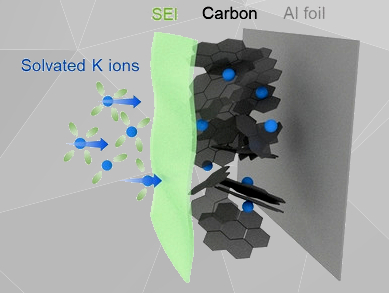Lithium-ion batteries (LIBs) are widely used but have issues regarding their sustainability. Potassium-ion batteries (KIBs) could be a promising alternative to LiBs, especially for large-scale grid storage. However, natural graphite has poor electrochemical performance in KIBs due to large volume changes when potassium ions (de-)intercalate between the graphitic layers. Developing high-energy carbon anodes for KIBs is, thus, an important research target.
Zhenyu Guo, Zhen Xu, Maria‐Magdalena Titirici, Imperial College London, UK, and colleagues have developed a carbon anode material for KIBs with a high reversible capacity by mixing a non-graphitizing soft carbon with graphite. Soft carbon was prepared via the pyrolysis of a mesophase pitch precursor. The desired composites were synthesized by mixing commercially available graphite powder with the pitch precursor in different mass fractions, followed by annealing in a tube furnace at 1100 °C under an N2 atmosphere.
The obtained carbon material has a structure in between soft carbon and graphite (schematically pictured). A graphite-to-soft-carbon ratio of 3:1 provides a charge capacity of 280.2 mAh g–1. The presence of soft carbon in the material influences the solid electrolyte interface (SEI) layer formation, provides structural protection to the graphitic layers, allows faster ion diffusion, and provides more active sites for ion storage in the carbon structures.
- Carbon Composite Anodes with Tunable Microstructures for Potassium-Ion Batteries,
Shengming Zhang, Anastasia A. Teck, Zhenyu Guo, Zhen Xu, Maria-Magdalena Titirici,
Batteries Supercaps 2021.
https://doi.org/10.1002/batt.202000306



